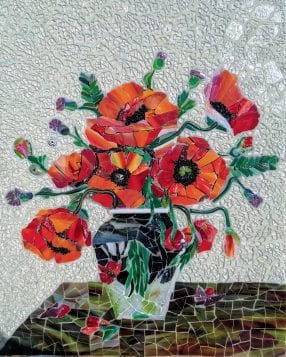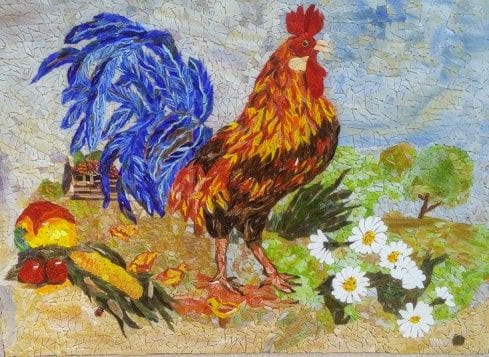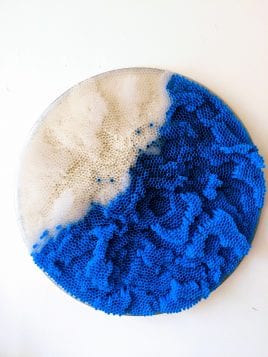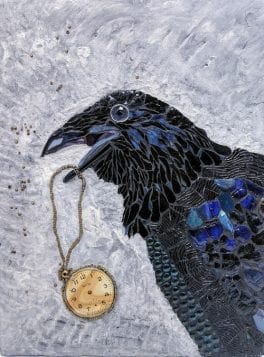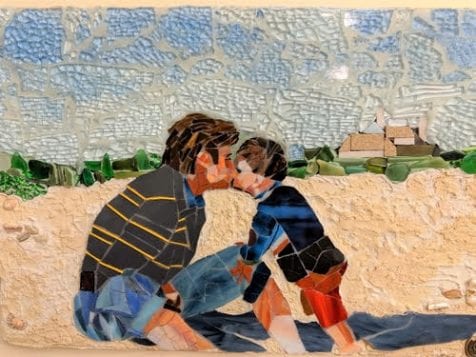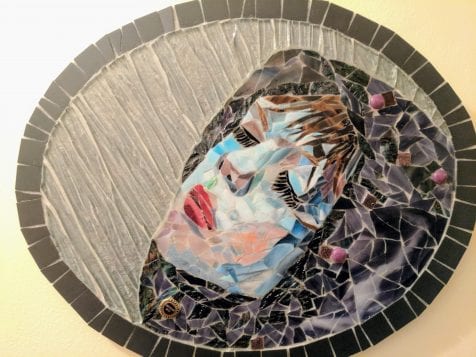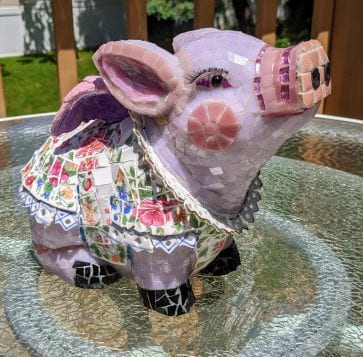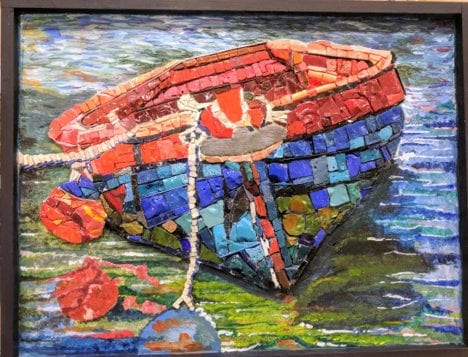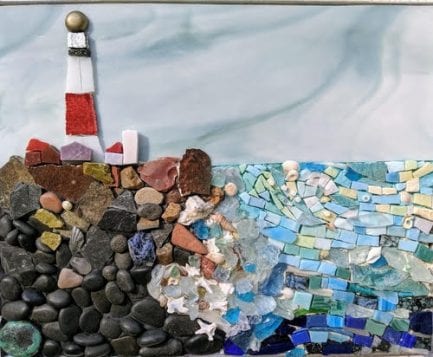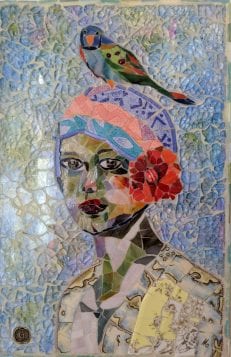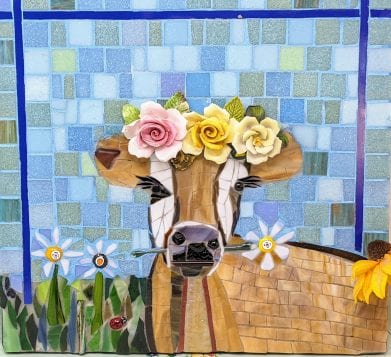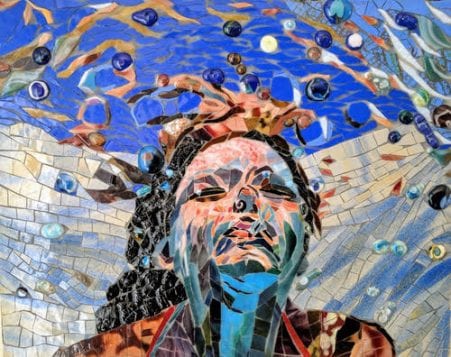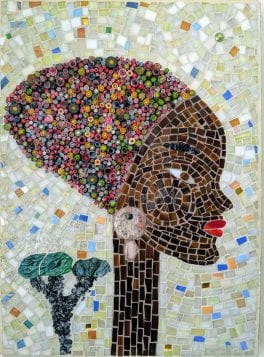Artist of the Month: Gabriella Grama
‘Mosaics are spellbinding; they bring forth a story by constructing together a thousand little pieces, just like life is created from thousands of moments, memories, and experiences.’
– Gabriella Grama
By Irene Ruddock

Gabriella Grama is an artist who specializes in fine art mosaics and whose artistic form of expression is a fusion of modern and traditional methods. Born in Romania, she has lived in Ronkonkoma for the past 25 years where she maintains her art studio. She has exhibited in many art galleries and shows on Long Island, mainly with the Women Sharing Art group, whose most recent exhibit was at the Islip Art Museum. Gabriella also enjoys commissions where she can do a special project for someone.
How did you begin your love of art?
As a young girl, I used to visit my grandfather who was a glassmaker in Transylvania, an area well-known for skilled craftsmanship in glass, wood, and pottery. The magical experience of seeing light filtered through colored glass ignited my life-long love for glass as an art form.
When did you begin your interest in mosaics?
I was a stained glass artist for ten years before I discovered mosaics. While remodeling my kitchen, I decided to try a mosaic backsplash, and, before it was completed, I was hooked with a new passion! To improve, to learn about the different types of materials, work methods, and tools, I started to study with mosaic masters both in the United States and Italy. Each year I take workshops in Venice, Ravenna, the Chicago School of Mosaics or continue my study with mosaic masters such as Carol Shelkin, Martin Cheek, Koko Mosaico, Carole Choucair Oueijan, etc.
How would you describe the art of mosaics?
Mosaics are assemblages composed of tesserae which are small pieces of glass, stone, or other nature-based materials. These pieces are typically cut into squares or shaped using special tools. The fragments are then arranged into patterns, pictures and other decorative designs held together by an adhesive and then grouted.
What is the history of mosaics?
Mosaics have a long history. First made out of ivory, seashells, and stones, they have been around since the third millennium B.C.E. Later on, mosaics with patterns, motifs, animal and human pictures were quite widespread in Ancient Greece and Rome.
What places have you visited that have inspired you to create mosaics?
When I travel, I not only enjoy the different places, people and culture, but also seek out the mosaic treasures that inspire and educate me. Mosaic artists usually take the beaten path to Italy to visit Pompeii and Ravenna or travel to Barcelona, Spain or Istanbul, Turkey. But one could also travel to Vietnam to visit the Imperial Tombs outside of the city of Hue or visit the outstanding modern subway mosaics in Pyongyang, North Korea which I saw while on a cultural exchange.
You mentioned that you were most inspired by your visit to Pompeii. What was it about this ancient city that pulled you into this art form?
Mosaic ornamentation was widely used in the decoration of the houses in Pompeii and the workmanship was very skilled. The Pompeii mosaics are technically brilliant, showing refinement in their composition, great taste in color and superb selection of the tesserae used.
“Cave Canem,” The Battle of Alexander,” or the maritime scene of fish swimming around an octopus wrestling with a lobster are just some of the mosaics that are constantly brought forward in time, ceaselessly reproduced, and instantly recognizable.
Can you tell me about the organization Women Sharing Art and why it is so important to you?
I am thrilled to be a part of this group of Long Island women artists who work in a variety of media: photography, watercolors, ceramics, pottery, etc. Since 2008, the organization has offered grants to its members, awarded scholarships to high school artists, while providing its members with numerous opportunities to participate in Long Island art exhibits. You may view my work and the work of all of our members at womensharingart.org.
What was the theme of your most recent exhibit with the group?
In February, we participated in the “I AM at the IAM” at the Islip Museum of Art in an exhibition celebrating the 100th anniversary of the passing of the 19th amendment to the Constitution guaranteeing the right of American woman to vote. A video of the exhibition can be viewed on You Tube: “I Am at the IAM.” Another way to see it is on a film posted on the Islip Art Museum Face Book page. (www.facebook.com/IslipArtMuseum/videos)
What was your experience working with Mercy Center Ministries?
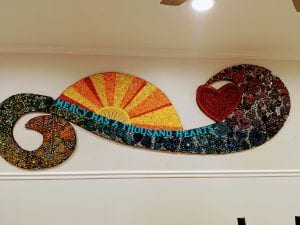
This is an independent living shelter for runaway or homeless teens. Artists from Women Sharing Art, community members, staff and residents created Mercy Has a Thousand Hearts, a unique mosaic that was installed in the Sayville Shelter. Funded by a grant received from New York State Council on the Arts and the Huntington Arts Council, the mosaic was a true work of love that gave hundreds of people the opportunity to try this form of art to express their creativity.
Is there another memorable project that has brought you fulfillment?
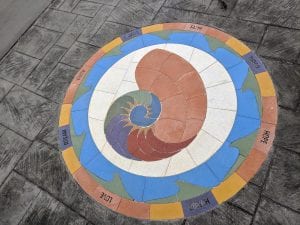
I am most proud of collaborating in 2019 with a fellow Long Island mosaic artist on the concept and design of a mosaic sidewalk medallion in Patchogue. “Nautilus Flowing” celebrates the diversity of Patchogue, its people and communities.
Tell me about your favorite piece?
One of my favorite pieces is “Effervescence”, a mosaic of a woman submerged just below the water surface. I wanted to bring to the viewer a woman experiencing a moment of solitude, serenity, and sublimity.
What are you working on now?
While I usually work on mosaic portraits (pet and human) or kitchen backsplashes, I am also experimenting with a dynamic, less traditional take on mosaics: I want to incorporate the look of weaved texture, cloth, in my mosaics. The mosaic pillows I made for a recent show inspired me to venture into a new direction. I am having a lot of fun breaking all sorts of ancient rules used in traditional mosaics!
Are you interested in teaching? How may someone get in touch with you?
Mosasics can be for everyone so all levels are invited to try it out. I currently conduct small group workshops at my studio. My contact information is [email protected], GabriellaGramaMosaics.com, womensharingart.org or Facebook: Gabriella Grama Mosaic Art.

